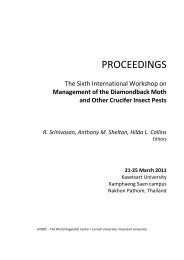Leguminous Vegetable Cultivation and Seed Production S ...
Leguminous Vegetable Cultivation and Seed Production S ...
Leguminous Vegetable Cultivation and Seed Production S ...
Create successful ePaper yourself
Turn your PDF publications into a flip-book with our unique Google optimized e-Paper software.
SEED PRODUCTION AND MANAGEMENT OF MUNGBEAN AND SOYBEAN 363<br />
Mungbean <strong>and</strong> soybean are self-pollinated, annual species reproduced by<br />
normal fertilization. In mungbean, natural outcrossing varies from 0.0 to 13%<br />
(Shanmugasundaram <strong>and</strong> Poehlman 1988). A high level of outcrossing can cause<br />
considerable variation in the seed produced. In India, when rnungbean seed was<br />
produced, a 1.5-m border was left unharvested between adjacent varieties (Kernick<br />
1961). Considering the large extent of outcrossing in some genotypes, the isolation<br />
requirement has been increased to 3 m.<br />
Usually, a plant breeder maintains a variety by planting single plant progeny<br />
<strong>and</strong> checking characteristics against the variety's official description. If the rows are<br />
uniform, they are bulked. In soybean, 30-50 kg of pedigree seed normally is reserved.<br />
In rnungbean, .10-15 kg of pedigree seed is reserved. In temperate <strong>and</strong> tropical<br />
countries, seed production rates vary because of the length of growing seasons <strong>and</strong><br />
the yield potential of varieties. Pedigree seed is planted on 0.5-1.5 ha to produce 1-3 t<br />
soybean <strong>and</strong> 0.3-1 t rnungbean basic seed.<br />
Basic seed is used to produce the subsequent categories of seeds (Shanrnugasundaram<br />
1982). At each stage, care is exercised to remove variants. In countries<br />
with official seed certification programs, designated agencies supervise <strong>and</strong> regulate<br />
seed certification.<br />
In India, a parastatal national seed corporation coordinates the production of<br />
certified seed through a series. of state seed farms that are profit-responsible. They<br />
were set up <strong>and</strong> funded by World Bank (Walker 1980). The All-India Coordinated<br />
Research Project on Soybean, in its annual meeting, allocates to each breeder the<br />
quantity of seed to be produced. For example, in 1985-86 breeders produced about<br />
92 t of basic seed of 20 new soybean varieties (P. S. Bhatnagar, pers. comm.).<br />
Factors to consider in seed production<br />
<strong>Seed</strong> production is a specialized activity. Preharvest <strong>and</strong> postharvest factors must be<br />
considered (Nangju et al 1978): field environment, cultural practices, genetic<br />
influence, <strong>and</strong> harvest time (Tekrony et al 1978) <strong>and</strong> biotic <strong>and</strong> abiotic factors<br />
(Roberts 1972b, Sinclair <strong>and</strong> Jackobs 1982).<br />
Basic constraints in seed production can be varietal (genetic characteristics),<br />
environmental, biological, <strong>and</strong> socioeconomic, alone or in combination. Vagaries of<br />
climate <strong>and</strong> soils must not be used as excuses for deficiencies in plant genetics,<br />
selection procedures, isolation distances, good crop management, <strong>and</strong> quality<br />
control (Walker 1980).<br />
Constraints such as photoperiod, temperature, soil properties, <strong>and</strong> rainfall<br />
cannot be controlled by the seed producer (Shanmugasundaram <strong>and</strong> Tsou 1987).<br />
L<strong>and</strong> preparation, organic or inorganic fertilizer applications, pest <strong>and</strong> disease<br />
control, <strong>and</strong> weed control <strong>and</strong> management are factors that can be regulated. A<br />
sufficient knowledge pool is available (for a review see Morton et al 1982, Nangju et<br />
al 1978, Scott <strong>and</strong> Aldrich 1970, Shanmugasundaram 1982, Shanmugasundaram<br />
<strong>and</strong> Tsou 1987, Sinclair <strong>and</strong> Jackobs 1982, Tekrony et al 1978). Although obtaining<br />
a high yield is a consideration, the most important criterion is producing good
















